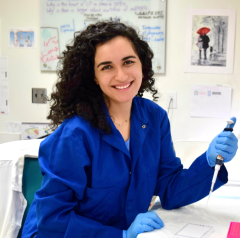The Eghbali Laboratory

The Eghbali Laboratory's work focuses on the molecular basis of the remodeling of voltage-activated K+ channels in the heart by sex hormones. Dr. Eghbali and her colleagues have identified a key molecule that controls the production of oxidized lipids, and is reduced in the lungs and blood of patients with pulmonary hypertension; this discovery could lead to the development of a new blood test to aid in early detection. Pulmonary hypertension is up to four times more common in women, and Dr. Eghbali's team is leading in the investigation, for the first time, of the role of sex chromosomes in the development of this devastating disease. The Y chromosome appears to be protective, and the team's goal is to identify the gene(s) on the Y chromosome responsible for the protective effect. This research may ultimately explain the prevalence of pulmonary hypertension among women and potentially elucidate a novel therapeutic approach to treatment. In addition, researchers in the Eghbali Laboratory have developed the first model of combined pulmonary fibrosis and pulmonary hypertension in rats, effectively simulating the human disease. They are focusing specifically on the study of a molecule called microRNA 125b-3p. This molecule may serve as a biomarker for disease progression, and may also serve as a therapeutic target for treatment.
Dr. Eghbali is our department’s Director of Physician-Scientist Training, and Director of the Basic Science Training Environment. She received her PhD degree from the John Curtin School of Medical Research, Australian National University.
Meet Our Team

Mansoureh Egbhali, PhD
Dr. Eghbali is a Professor in the Department of Anesthesiology at UCLA. She is also Director of Physician-Scientist Training Program, and Director of the Basic Science Training Environment in our department. She received her PhD degree from the John Curtin School of Medical Research, Australian National University in 1999 followed by a posdoctoral training at UCLA (1999-2002). Her lab studies the molecular and cellular mechanisms underlying the development and progression of heart disease (heart failure, myocardial ischemia/reperfusion injury, and cardiac arrest induced by anesthetic overdose), and lung disease (pulmonary hypertension and acute lung injury), and to develop novel therapeutics such as micro-RNAs for heart disease and lung disease. Her lab also studies sex differences in cardiovascular disease in particular the role of estrogen, estrogen receptors and more recently the role of sex chromosomes.

Gregoire Ruffenach, PhD
My research focuses on pulmonary vascular diseases that are life-threatening diseases affecting all ages from newborn to elderly patients. My research aims to unravel the molecular mechanism at the root of pulmonary vascular disease to discover novel therapeutics
Grant funding
- 20CDA35350059 7/1/2020 - 06/30/2023
- Career Development Award, American Heart Association
- 20POST35210727 01/01/2020- 06/31/2020
- Postdoctoral Fellowship, American Heart Assocation
- AHA-17POST33670424 7/1/2017-6/30/2019
- Postdoctoral Fellowship, American Heart Association
Awards:
- 2019 UCLA Postdoctoral Chancellor Award
- 2018 Poster Competition, Division of Molecular Medicine, UCLA, 1st prize
- 2018 Abstract Scholarship, American Thoracic Society
- 2018 Best basic science fellow, UCLA scientific evening, 1st prize
- 2017 Best Abstract American Society of Anesthesiology, finalist
- 2017 Travel Award American Heart Association -BCVS New Investigator
- 2016 Best abstract Award UCLA Cardiovascular symposium
- 2015 Abstract Scholarship: American Thoracic Society
- 2015 Best abstract Canadian Thoracic Society, finalist

Lejla Medzikovic, PhD
Molecular mechanisms underlying cardiac and pulmonary fibrosis and calcification. Lejla obtained her PhD in cellular and molecular cardiology at the University of Amsterdam, The Netherlands in September 2018. She started her postdoc in the Eghbali lab shortly after. View the list of her publications.

Lisa Lee, MD
My current research analyzes the differences in the miRNA expression profile of survivor vs. non-survivor pediatric patients with ARDS.

Christine Cunningham
Christine is a PhD candidate interested in sex chromosome effects in ischemic heart disease and pulmonary hypertension. Our lab found striking effects of X chromosome dosage in ischemic heart disease (one X vs two) and a protective effect of the Y chromosome in pulmonary hypertension. Christine's research focuses on unraveling the molecular mechanism as to how sex chromosomes impart sex-specific bias in order to better understand the role of sex in cardiovascular pathophysiology and creatively identify novel pathways for therapeutic intervention. Christine's work has been supported by a T32 training grant, an American Heart Association Predoctoral Fellowship, the 2019 CTSI/Iris Cantor Women's Health Center Young Investigator Fellowship, and a Dissertation Year Fellowship. Christine is looking forward to a career in academic research and is passionate about science, medicine, and increasing female representation in STEM.

Jason Hong, MD
Jason Hong is researching single-cell and multi-omic approaches to understanding pulmonary arterial hypertension.

Laila Aryan
Laila is a PhD student interested in the molecular mechanisms underlying cardiovascular disease during pregnancy. Heart attacks have been reported to occur more frequently and carry a worse prognosis during pregnancy for unclear reasons. Our lab has reported that the late-pregnant rodent is more prone to myocardial ischemia-reperfusion injury compared to the non-pregnant rodent. Laila’s research focuses on unraveling the molecular mechanisms involved in the higher susceptibility of late pregnancy to ischemia-reperfusion injury, with a specific focus on the role of microRNAs. She hopes to find therapeutic targets for the treatment of pregnant women who are at higher risk of cardiovascular disease. View the list of her publications.

Eranthi Jayawardena
Eranthi Jayawardena's research aims to understand underlying mechanisms of acute myocardial ischemia-reperfusion injury with the goal of discovering new therapies and cures.

Min Li, PhD
Min received her Ph.D. from Peking Union Medical College in China. She joined Dr. Eghbali’s lab in 2017. She had many years of experience in molecular biology techniques as well as mouse model of myocardial ischemia-reperfusion injury. She is interested in the study of molecular mechanisms behind sex difference in myocardial ischemia-reperfusion injury and pulmonary hypertension as well as to explore the therapeutic strategies for these diseases.
Photo Gallery

Recent Publications
Iorga A, Umar S, Ruffenach G, Aryan L, Li J, Sharma S, Motayagheni N, Nadadur RD, Bopassa JC, Eghbali M. Estrogen Rescues Heart Failure Through Estrogen Receptor Beta Activation. Biol Sex Differ; October 2018 9(1):48. doi: 10.1186/s13293-018-0206-6. PMID: 30376877. https://www.ncbi.nlm.nih.gov/pubmed/30376877
We have previously shown that estrogen treatment rescues heart failure in mice. In this paper we show the rescue action of estrogen is mainly mediated through estrogen receptor beta.
Umar S., Li J., Hannabass K., Vaillancourt M., Cunningham CM, Moazeni S. Mahajan A, & Eghbali M. (2018). Free Fatty Acid Receptor GPR40 Mediates Lipid Emulsion-induced Cardioprotection. Anesthesiology:129(1):154-162. doi: 10.1097/ALN.0000000000002195. PMCID: PMC6084795. https://www.ncbi.nlm.nih.gov/pubmed/29620570
This paper highlights the mechanisms of direct cardioprotective effects of lipid emulsion. More importantly, we have identified the key cell membrane receptor responsible of the effects of lipid emulsion in the heart.
Umar S., Cunningham C.M., Itoh Y., Moazeni S., Vaillancourt M., Sarji S. Centala A., Arnold A.P. & Eghbali M. (2018). The Y Chromosome Plays a Protective Role in Pulmonary Hypertension. American Journal of Respiratory and Critical Care Medicine: 197(7):952-955. doi: 10.1164/rccm.201707-1345LE. PMID: 28934553. https://www.ncbi.nlm.nih.gov/pubmed/28934553
The role of sex chromosomes in the development of pulmonary hypertension has not been studied in the past. We conducted the first investigation of the role of sex chromosomes, in the absence of gonadal hormones, in the development of hypoxia-induced PH using the unique Four Core Genotypes (FCG) and XY* mouse models. We found that the Y chromosome is protective against development of hypoxia-induced pulmonary hypertension in gonadectomized mice. UCLA newsroom: http://newsroom.ucla.edu/releases/genes-on-y-chromosome-protect-against-pulmonary-hypertension-study-suggests
Cunningham C.M., Eghbali M. (2018). An Introduction to Epigenetics in Cardiovascular Development, Disease, and Sexualization. Adv Exp Med Biol:1065:31-47. doi: 10.1007/978-3-319-77932-4_2. https://www.ncbi.nlm.nih.gov/pubmed/30051375
This review summarizes the field of epigenetics in the context of cardiovascular development and disease while also highlighting the role of epigenetic regulation including DNA methylation, histone modification as well as non coding RNA-based regulation as powerful sources of sex differences within the cardiovascular system.
Saddic LA, Howard-Quijano K, Kipke J, Kubo Y, Dale EA, Hoover DB, Shivkumar K, Eghbali M., Mahajan A. (2018). Progression of Myocardial Ischemia Leads to Unique Changes in Immediate Early Gene Expression in the Spinal Cord Dorsal Horn. Am J Physiol Heart Circ Physiol. doi: 10.1152/ajpheart.00337.2018. PMID: 30216122. https://www.ncbi.nlm.nih.gov/pubmed/30216122
The pathological consequences of ischemic heart disease involve signaling through the autonomic nervous system. In this paper using acute and chronic myocardial ischemia in a large animal model of Yorkshire pigs, we identified genes that were differentially expressed in acute and chronic model compared to control in the thoracic dorsal horn using RNA-Seq analysis.
Barske J, Eghbali M, Kosarussavadi S, Choi E, Schlinger BA. (2018). The Heart of an Acrobatic Bird. Comp Biochem Physiol A Mol Integr Physiol. pii: S1095-6433(18)30251-4. doi: 10.1016/j.cbpa.2018.10.010. PMID: 30367962. https://www.ncbi.nlm.nih.gov/pubmed/30367962
In this paper we characterize the heart of an arobatic male (manakin) bird which has the highest heart rates during acrobatic courtship dance recorded in any bird or mammal. We found the manakin heart had a significantly thicker left ventricular with a smaller left ventricular chamber as well as significantly greater gene expression of ryanodine receptors and androgen receptors. Testosterone treatment of non-breeding manakins increased gene expression of the Ca2+ pump SERCA.
Touma M., Kang X., Gao F., Zhao Y., Cass A.A., Biniwale R., Xiao X., Eghbali M., Coppola G., Reemtsen B., & Wang Y. (2017). Wnt11 Regulates Cardiac Chamber Development and Disease During Perinatal Maturation. JCI Insight. 2017 September. 2(17). pii: 94904. doi: 10.1172/jci.insight.94904. PMC5621892. https://www.ncbi.nlm.nih.gov/pubmed/28878122
Ventricular chamber growth and development during perinatal circulatory transition is critical for functional adaptation of the heart. In this paper systems genomic and functional biology analyses of the perinatal chamber specific transcriptome, we identified Wnt11 as a prominent regulator of chamber-specific proliferation. We also show downregulation of Wnt11 expression was associated with cyanotic congenital heart defect phenotypes and correlated with O2 saturation levels in hypoxemic infants. Wnt11 inactivation was sufficient to induce myocyte proliferation in perinatal mouse hearts and downregulation of Wnt11 in hypoxemic infantile hearts was associated with Rb1 suppression and induction of proliferation markers. Defining the underlying regulatory mechanism may yield chamber-specific therapies for infants born with CHDs.
Vaillancourt M., Chia P., Sarji S., Nguyen J., Hoftman N., Ruffenach G., Eghbali M., Mahajan A. & Umar S. (2017). Autonomic Nervous System Involvement in Pulmonary Arterial Hypertension. Respir Res. 2017 December. 18(1):201. doi: 10.1186/s12931-017-0679-6. PMCID: PMC5715548. https://www.ncbi.nlm.nih.gov/pubmed/29202826
Autonomic nervous system involvement in the pathogenesis of pulmonary arterial hypertension has been demonstrated several years ago, however the extent of this involvement is not fully understood. This review summarizes the multiple aspects of autonomic nervous system involvement in pulmonary arterial hypertension and overview the different pharmacological and invasive strategies used to target autonomic nervous system for the treatment of pulmonary arterial hypertension.
Iorga A., Cunningham C.M., Moazeni S, Ruffench G, Umar S. & Eghbali M. (2017). The Protective Role of Estrogen and Estrogen Receptors in Cardiovascular Disease and the Controversial Use of Estrogen Therapy. Biol Sex Differ 2017 October. 8(1):33. doi: 10.1186/s13293-017-0152-8. PMID: 29065927. https://www.ncbi.nlm.nih.gov/pubmed/29065927
This review summarizes the protective role of estrogen and its receptors in the cardiovascular system and discusses its underlying mechanisms with an emphasis on oxidative stress, fibrosis, angiogenesis, and vascular function. The controversies surrounding the clinical use of exogenous estrogen as a therapeutic agent for cardiovascular disease in women due to the possible risks of thrombotic events, cancers, and arrhythmia are also discussed.
Li J, Ruffenach G, Kararigas G, Cunningham CM, Motayagheni N, Barakai N, Umar S, Regitz-Zagrosek V, Eghbali M. Intralipid Protects the Heart in Late Pregnancy Against Ischemia/reperfusion Injury via Caveolin2/STAT3/GSK-3β Pathway. J Mol Cell Cardiol. Jan. 2017 – Vol 102, p. 108-116. https://doi.org/10.1016/j.yjmcc.2016.11.006
The heart of a rodent in late pregnancy is more prone to ischemia/reperfusion injury compared to that of a non-pregnant rodent. Intralipid, an emulsion of fatty acids, protects the heart in late pregnancy against ischemia/reperfusion injury by inhibiting the mPTP opening through the Cav2/STAT3/GSK-3β pathway.
Arnold A.P, Cassis L.A., Eghbali M., Reue K. & Sandberg K. (2017). Sex Hormones and Sex Chromosomes Cause Sex Differences in the Development of Cardiovascular Diseases. Arteriosclerosis, Thrombosis, and Vascular Biology. 2017;37:746-756. https://doi.org/10.1161/ATVBAHA.116.307301
This review summarizes recent evidence concerning hormonal and sex chromosome effects in obesity, atherosclerosis, aneurysms, ischemia/reperfusion injury, and hypertension. Cardiovascular diseases occur and progress differently between sexes due to sex-specific protective and harmful effects. Gonadal hormones, especially estrogens and androgens, have long been found to account for some sex differences in cardiovascular diseases, and molecular mechanisms mediating these effects have recently been elucidated. More recently, the effects of sex chromosome genes have also been implicated as contributors in animal models of cardiovascular diseases, especially a deleterious effect of the second X chromosome found in females but not in males.
Vaidya B., Pangallo M., Ruffenach G., Cunningham C.M., Perron J.C., Kolluru S., Eghbali M., Gupta V. (2017). Advances in Treatment of Pulmonary Arterial Hypertension: Patent Review. Expert Opin Ther Pat. 2017 Aug;27(8):907-918. http://dx.doi.org/10.1080/13543776.2017.1313232
Pulmonary arterial hypertension (PAH) has recently been considered as a cancer-like disease with over-proliferation of pulmonary arterial smooth muscle cells and dysfunction of endothelial cells. New cellular and molecular biological advances have revealed novel target/pathways involved in the pathogenesis and progression of PAH. This review highlights recently filed patents describing novel agents acting on investigational targets as well as novel compounds with improved characteristics acting on established targets. Patents describing combinations of conventional and investigational compounds are also discussed.
Umar S, Partow-Navid R, Ruffenach G, Iorga A, Moazeni S, Eghbali M. Severe Pulmonary Hypertension in Aging Female Apolipoprotein E-deficient Mice Is Rescued by Estrogen Replacement Therapy. Biol Sex Differ. 2017 Mar 20;8:9. doi: 10.1186/s13293-017-0129-7. eCollection 2017. PMID: 28344760. https://www.ncbi.nlm.nih.gov/pubmed/28344760
The combined role of female sex, oxidized lipids and aging in pulmonary hypertension has not been investigated before. Hence, we investigated the development of pulmonary hypertension in young and middle-aged female Apolipoprotein E-deficient mice and explored the role of estrogen replacement therapy for aging females. Our results suggested that only aging female Apolipoprotein E-deficient but not wild type mice developed severe pulmonary hypertension compared to younger females. Exogenous estrogen therapy rescued pulmonary hypertension and right ventricular hypertrophy possibly through restoration of lung estrogen receptor beta expression.
Sharma S, Ruffenach G, Umar S, Motayagheni N, Reddy ST, Eghbali M. Role of Oxidized Lipids in Pulmonary Arterial Hypertension. Pulm Circ. 2016 Sep;6(3):261-73. doi: 10.1086/687293. Review. PMID: 27683603. https://www.ncbi.nlm.nih.gov/pubmed/27683603
We focused on the current understanding of the role of oxidized lipids, lipid metabolism, peroxidation, and oxidative stress in the progression of pulmonary hypertension. This review also discussed the relevance of apolipoprotein A-I mimetic peptides and microRNA-193, which are known to regulate the levels of oxidized lipids, as potential therapeutics in pulmonary hypertension.
Anwar A, Ruffenach G, Mahajan A, Eghbali M, Umar S. Novel Biomarkers for Pulmonary Arterial Hypertension. Respir Res. 2016 Jul 20;17(1):88. doi: 10.1186/s12931-016-0396-6. Review. PMID: 27439993. https://www.ncbi.nlm.nih.gov/pubmed/27439993
A simple non-invasive test to frequently monitor the patients with pulmonary hypertension is much needed. Search for a novel biomarker for pulmonary hypertension that can be detected by a simple test is ongoing and many different options are being studied. Here we reviewed some of the new and unique pre-clinical options for potential pulmonary hypertension biomarkers. A biomarker that can be detected in blood, urine or breath condensate and correlates with disease severity, progression and response to therapy may result in significant cost reduction and improved patient outcomes.
Arnold AP, Reue K, Eghbali M, Vilain E, Chen X, Ghahramani N, Itoh Y, Li J, Link JC, Ngun T, & Shayna Williams-Burris.The Importance of Having Two X Chromosomes. Philos Trans R Soc Lond B Biol Sci. 2016 February 371(1688):20150113. doi: 10.1098/rstb.2015.0113.PMCID:4785899.https://www.ncbi.nlm.nih.gov/pubmed/26833834
Historically, it was thought that the number of X chromosomes plays little role in causing sex differences in traits. Recently, selected mouse models with the same type of gonad but with one versus two copies of the X chromosome demonstrates that mice with one X chromosome can be strikingly different from those with two X chromosomes. The review summarizes the studies demonstrating number of X chromosomes affects adiposity and metabolic disease, cardiovascular ischemia/reperfusion injury and behaviour.
Iorga A, Li J, Sharma S, Umar S, Bopassa JC, Nadadur RD, Centala A, Ren S, Saito T, Toro L, Wang Y, Stefani E, Eghbali M. Rescue of Pressure Overload-Induced Heart Failure by Estrogen Therapy. J Am Heart Assoc. 2016 Jan 22;5(1). pii: e002482. doi: 10.1161/JAHA.115.002482. PMID: 26802104. https://www.ncbi.nlm.nih.gov/pubmed/26802104
Estrogen pre-treatment has been shown to attenuate the development of heart hypertrophy, but it was not known whether estrogen could also rescue heart failure. We discovered that estrogen rescues pre-existing heart failure in mice by restoring cardiac estrogen and aromatase levels, stimulating cardiac angiogenesis, and by suppressing myocardial fibrosis.
